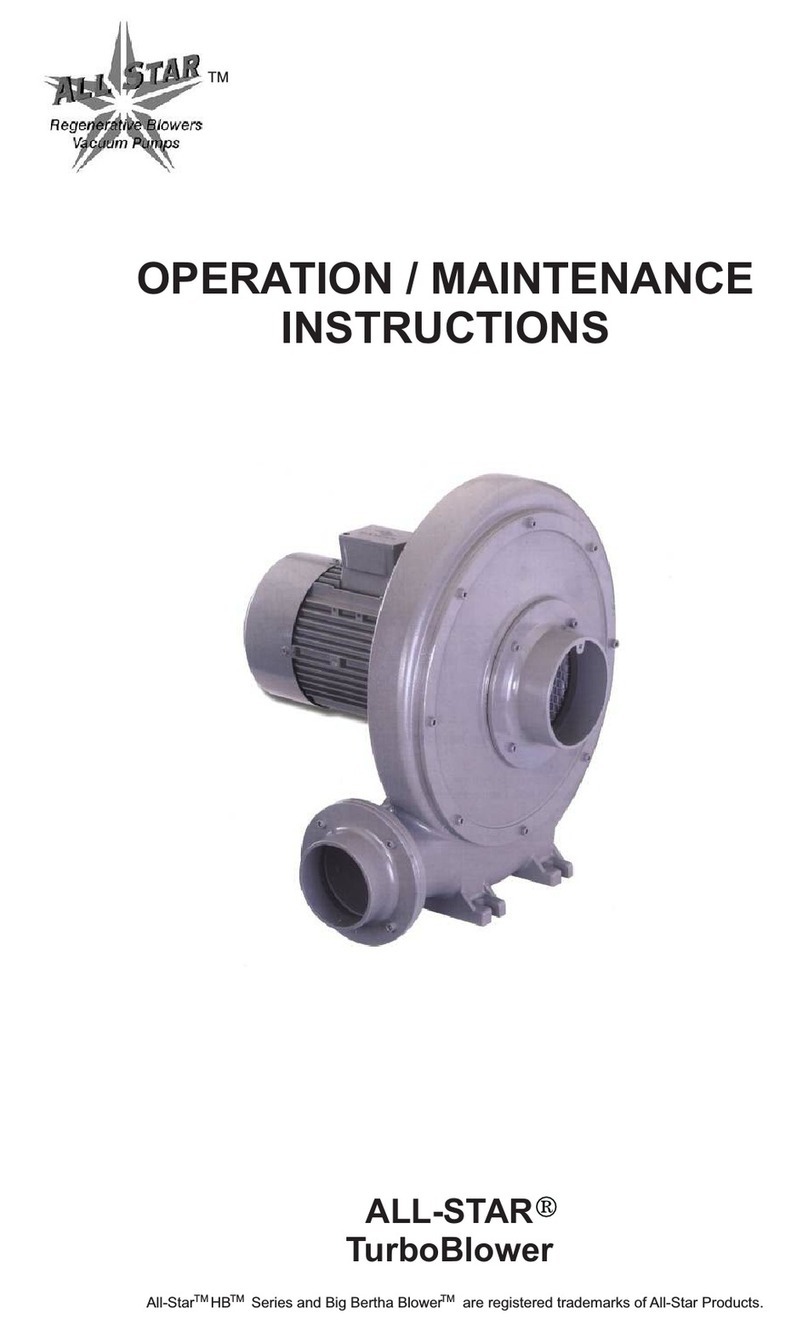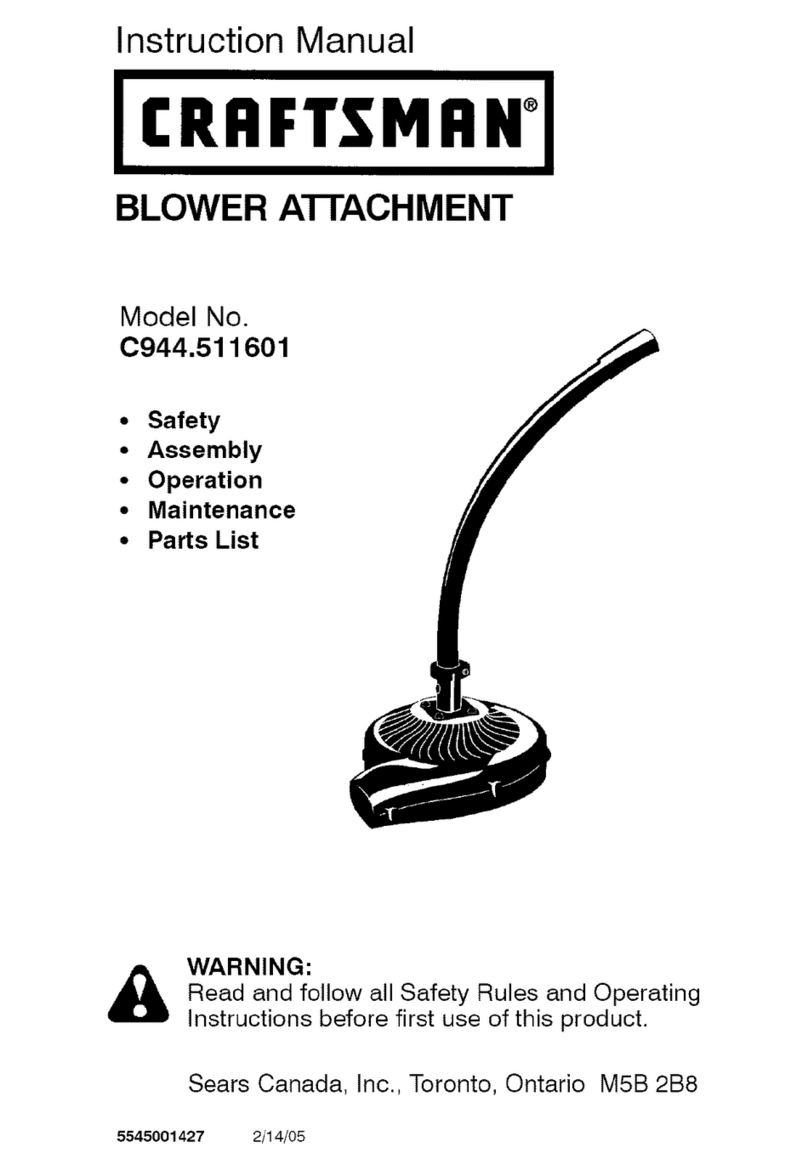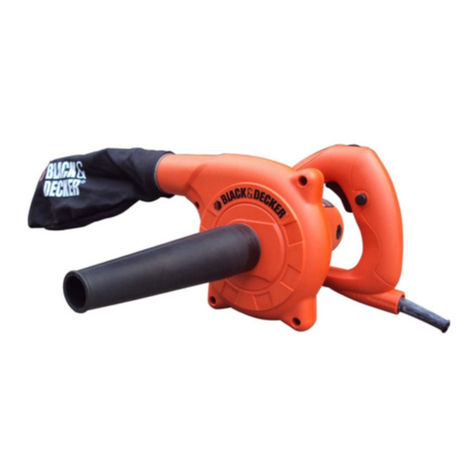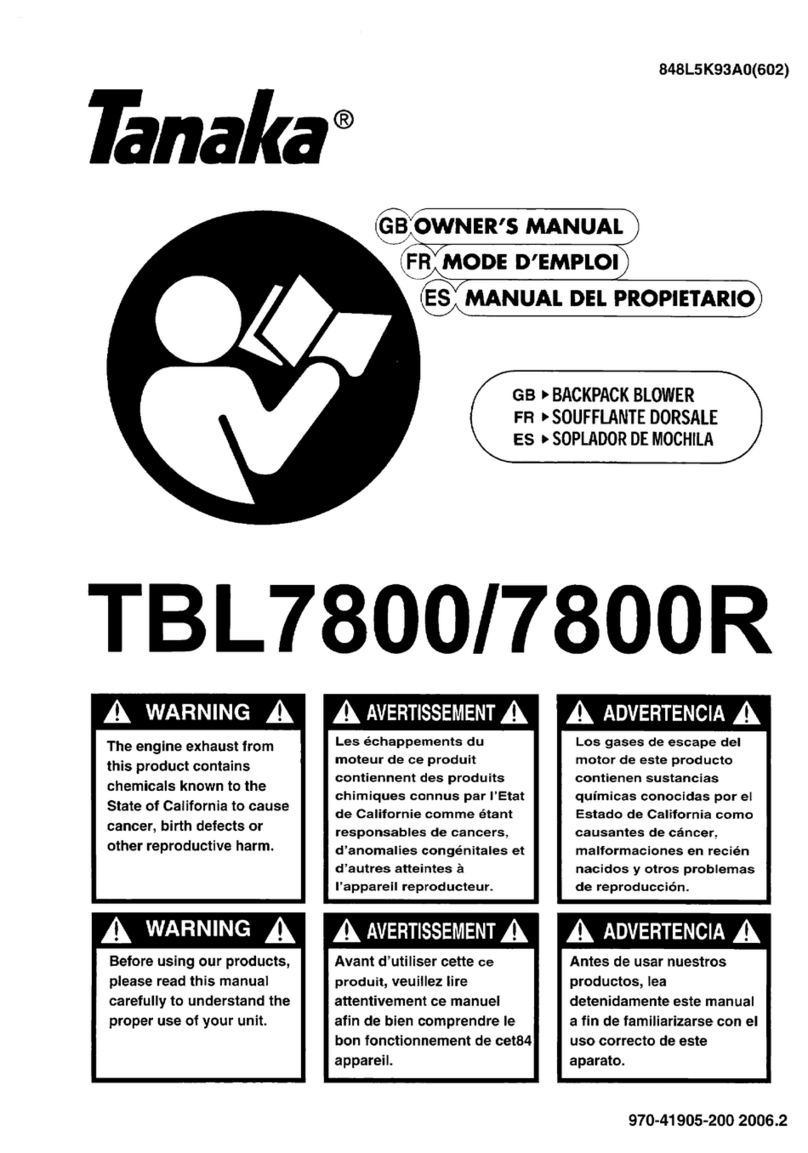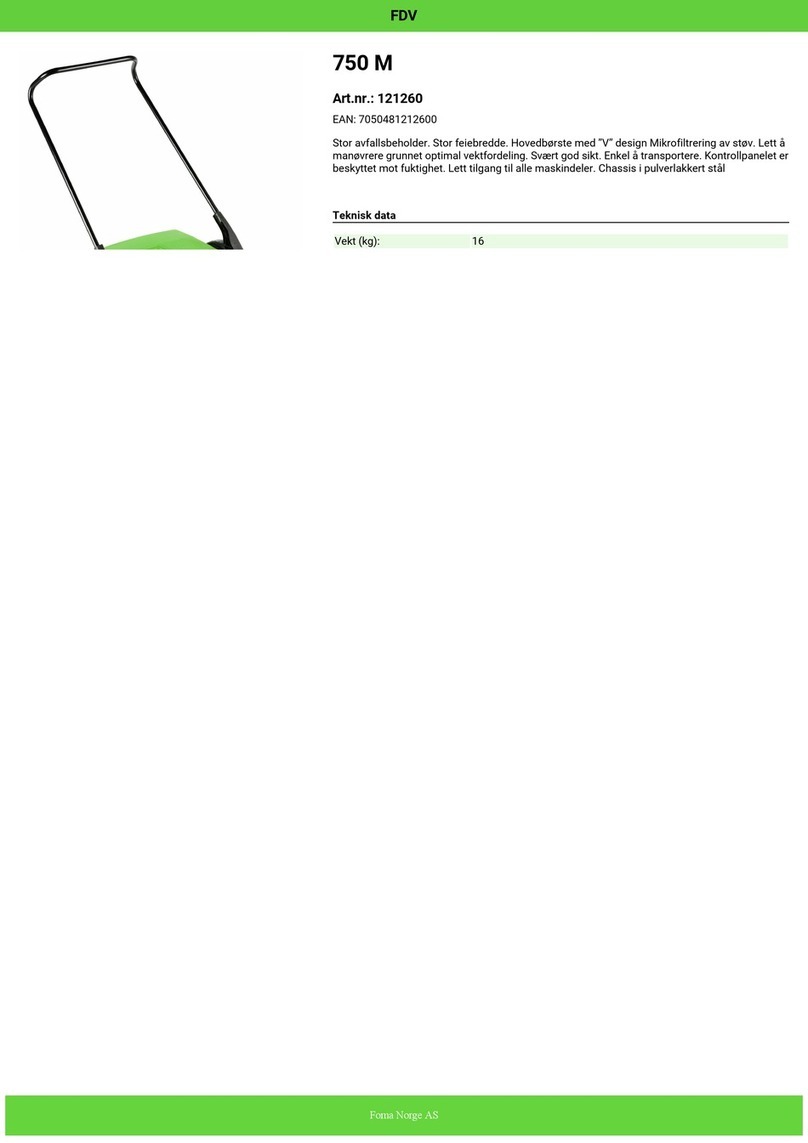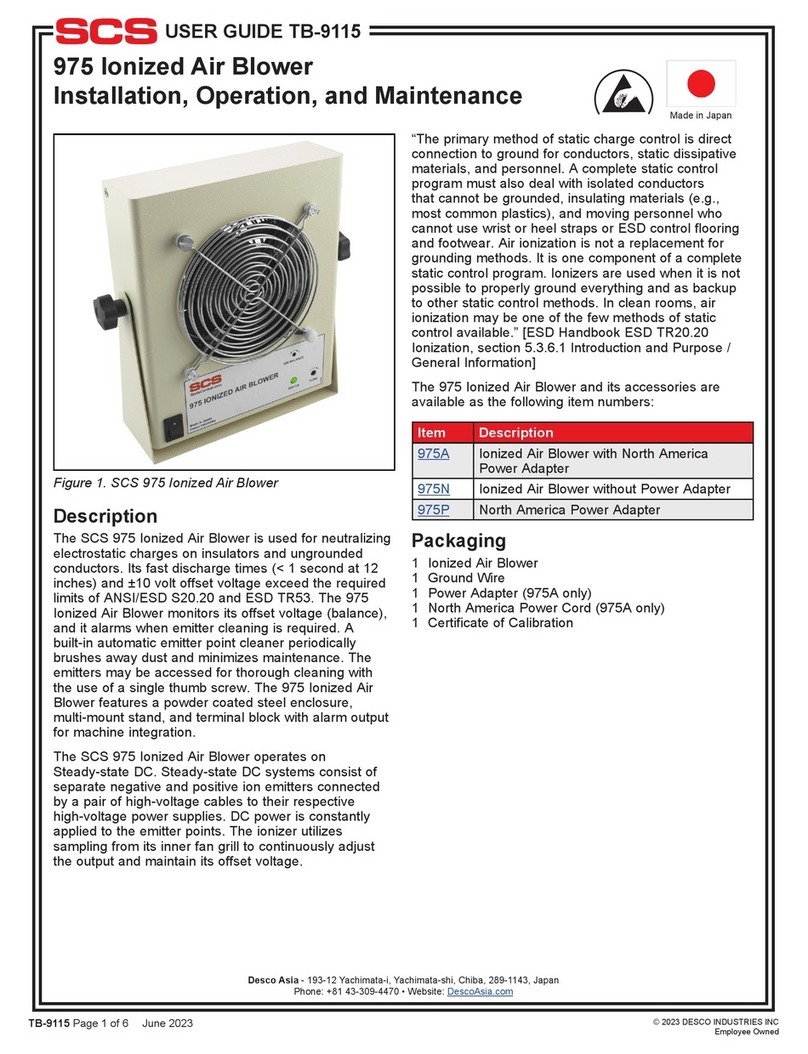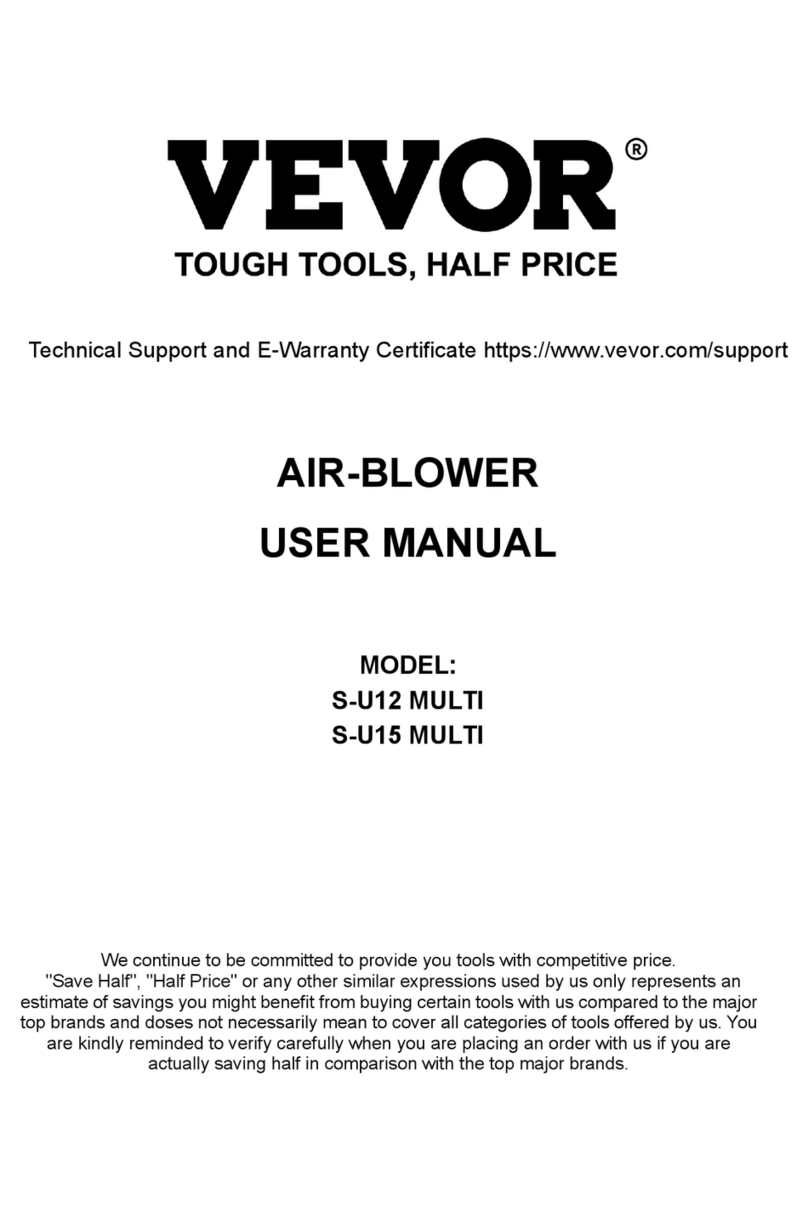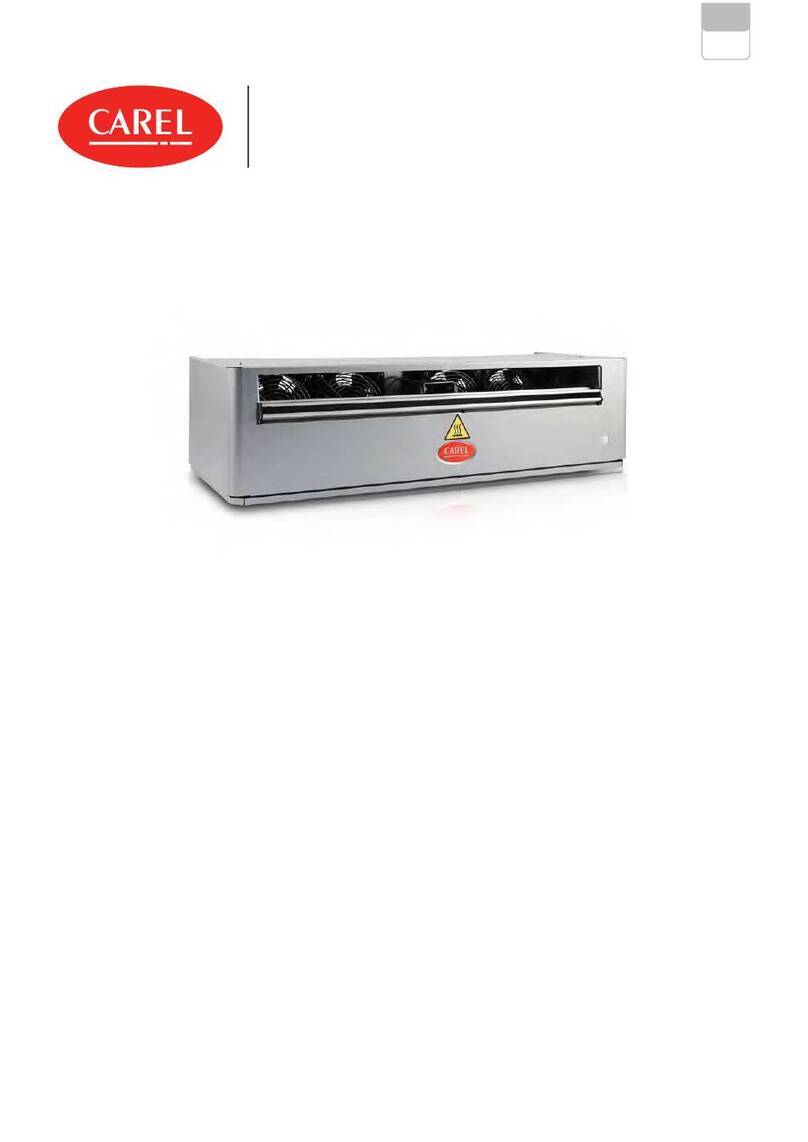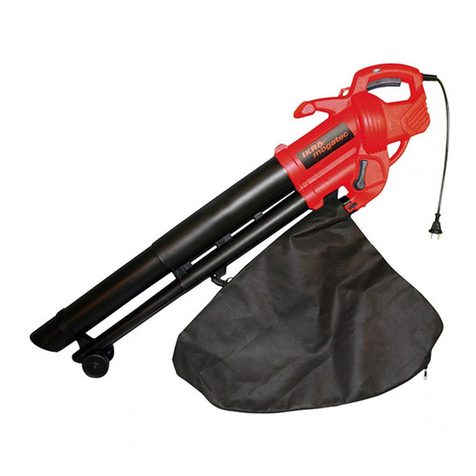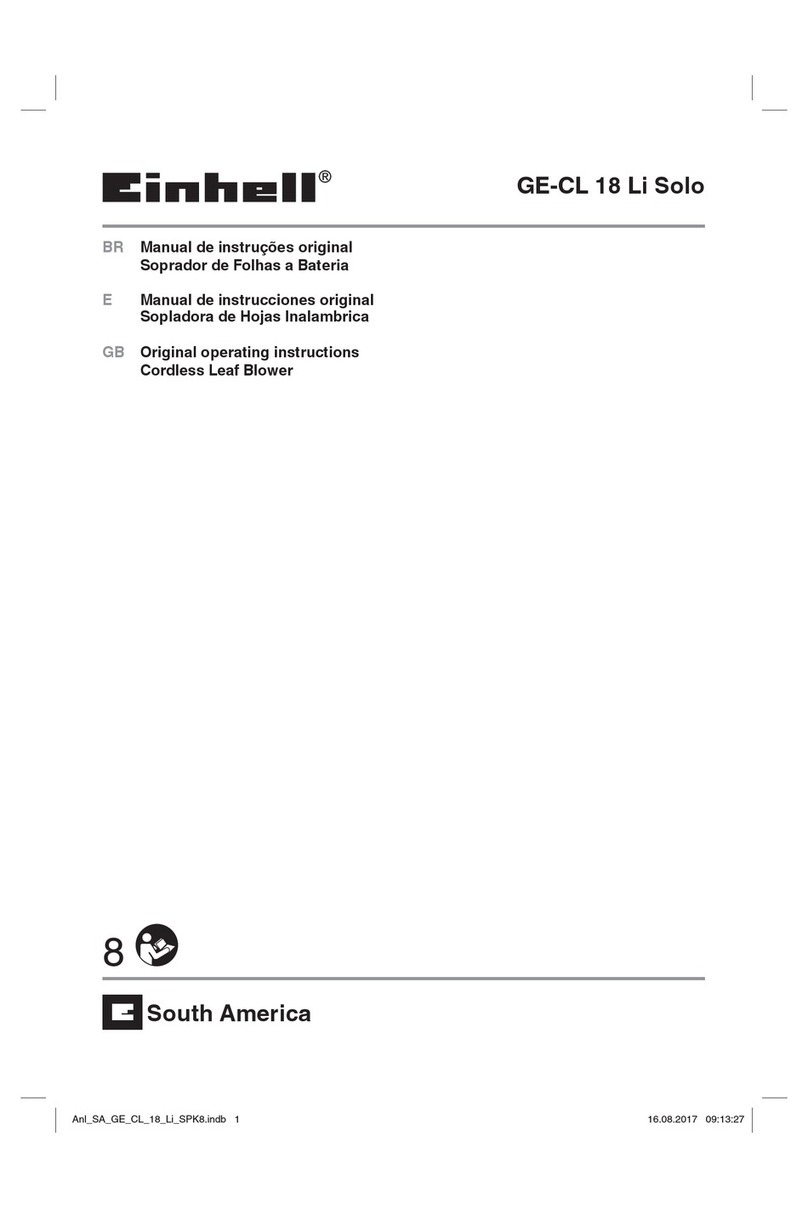All-Star Products RB1 Series Instruction Manual

OPERATION/MAINTENANCE
INSTRUCTIONS
REGENERATIVE BLOWER
Series and BigBertha Blower Are registered trade marks of All-StarProducts.
TM
All-Star HBTM TM
ISO
9001 RoHS
Compliant
CE
Registered and approved by one or more of these standards agency

Sample Installation Layout
Typical Vacuum
Arrangement
Typical Pressure
Blower
Arrangement
Vacuum
Pressure
Inlet
Filter
Flow Meter Inlet Filter
Vent
Line
Check
Valve
Pressure
ReliefValve Pressure
Gauge
3 pipe diameters
+/-1 diameter
3 pipe diameters
+/-1 diameter System
Discharge
Min 2pipe
diameters
Min 5pipe
Diameters from
Inlet or flowmeter
Blower
Vacuum
Pressure
Intake
Silencer
Inlet
Filter
3 pipe diameters
+/-1 diameter
System
Inlet
5 pipe
diameters
3 pipe diameters
+/-1 diameter
2pipe
diameters
Vacuum
Gauge VacuumRelief
Valve
Flow
Meter
Discharge
Silencer
-1-
1. Recommended piping should be one diameter larger than the inlet and outllet
diameter until piping has reach the working area.
2. Due to the high discharge temperature, metal piping is recommended for the
first 5 to 8 feet distance from the blower on pressure applications.
3 Elbows increase frictional loss. Keep the number of right angle bends to a
minimum.
4. Pressure relief valves should be installed in a “T” fitting that is at least one
pipe diameter than the exhaust port diameter. For safety reasons, it is highly
recommended to set the relief valve below the application pressure level.
5. Discharge air temperature increases at pressures greater than 65” H2O.
All discharge piping must be marked “DANGER-HOT-DO NOT TOUCH”.
6. IMPORTANT: To insure warranty coverage on the blower, a properly sized
air filter and relief valve must be installed. If not installed, the blower will not
be covered by the All-Star warranty.

Mounting Position of Discharge Silencers
on 2-Stage High Pressure Models
Standard 2-stage high pressure blowers are now supplied with
the discharge silencer housing facing towards the rear of the
blower as shown in Position B, below.
This new mounting position provides a more compact package.
A separate set of mounting parts are included with each blower
to allow customers to change the direction of the mounting
flange to position “A”.
If mounting position “B” is desired, the extra mounting parts
can be discarded.
Should you have any questions regarding this conversion, feel
free to contact All-Star Products at 800-431-8258.
DISCHARGE POSITION “A”
-2-
DISCHARGE POSITION “B”

1 INTRODUCTION
!
!
!DANGER
CAUTION
1.1 Application
1.2 Suction and compressor pressure
1.3 Environment (Ambient) Temperature
-3-
To insure safe operation of your All-Star blower, please read this
instruction manual and pay particular attention to the instructions
marked with the following signs.
Indicates an imminently hazardous
situation which, if not avoided, will
result in death or serious injury.
Indicates a potentially hazardous
situation, which, if not avoided, could
result in death or serious injury.
WARNING
Indicates a potentially hazardous
situation, which, if not avoided, may
result in minor or moderate injury.
The All-Star blower is a complete unit, ready for immediate
installation as a vacuum pump or as a compressor.
It is designed for handling air and other non-flammable
non-corrosive and non-explosive gasses only.
The drive motor can be loaded to the total differential pressure
given in the Technical Data Table. Blowers with limited
performance curves in the high pressure ranges should be
fitted with relative pressure relief valves in order to avoid
overloading of the motor. Pressure relief valve can be mounted
directly on the outlet and vacuum relief valves can be mounted
directly on the inlet of the blower.
The blower motor rating is based on an ambient temperature of
40 Deg C (104 Deg F). For operation in higher temperature
ambients, refer to All-Star Products.

forma ific
1.4 Per nce Spec ations
rP ior
el
Mod
HB-1291
-
HB-129
HB-129-12
HB 129A-
HB-22 -1
9
H -229
B
HB329-1-
HB- 9
32
HB-439
HB- 29
7
HB-829
HB-919
B-929
H
HB 939-
B3326H -
HB-4 7
33
H-434B 6
HB-6346
HB 6355
-
HB- 375
6
H-6455B
HB-6475
HB-8310
HB-8 153
HB-8320
HB-8410
HB 8415
-
HP o
Vltage Current
umMaxim
Pfo an
er rm ce ound
S
db(A)
Wt
lbs
CFM * V S P *
.25
.25
.33
.33
.67
.67
1.1
1.1
2
3
8.5
11.5
15
20
30
3.5
5
6.1
6.1
8.5
11.5
8.5
11.5
11.5
17.5
25
11.5
17.5
/61 0/115/230
/23/60 08-230/460
11/60/1 5/230
3/60/208-230/460
1/60/115/230
60 0
3/ /208-230/46
3
1/60/115/2 0
303/60/208-2 /460
3 /4/60/208-230 60
3
3/60/208-2 0/460
3/4/60/208-230 60
/2
3/60 08-230/460
8-3/60/20 230/460
23/60/208- 30/460
-
3/60/208230/460
03/60/208-23 /460
/6 63 0/208-230/4 0
8
3/60/20 -230/460
3/60/208-230/460
33/60/208-2 0/460
0 03/6 /208-230/46
03/60/2 8-230/460
2
3/60/208- 30/460
03/60/208-23 /460
/6 6
30/208-230/4 0
083/60/2 -230/460
3/60/208-230/460
3.4 / 1.7
.94 / .86 / .43
3.6 / 1.8
.2 / 1.1
1 4 /.67
5.8 / 2.9
.12.4 / 2.2 / 1
14 / 7
/ 1.9
4 / 3.7
/ 4.59.7 / 9.0
28.6 / 26.0 / 13.0
36.3 / 33.0 / 16.5
47 .4.4 / 42.8 / 21
65 / 59.6 / 29.8
/ 88
93 / 44
0.0 / 9
1.1 / 4.6
2.9 / 6
14.3 / 1 .5
/ 7.817.2 / 15.5
17.6 / 16.0 / 8.0
8.6 / 26.0 /13.02
/ 33.0 /
36.3 16.5
/ 12.2
27.9 / 25.3
35 .2
.9 / 32.5 / 16
.3 / 32.536 / 16.2
53 / 48.0 / 24.0
75.0 / 68.5 / 34.3
38
63
105
105
105
551
400
850
850
850
105
165
165
230
230
230
340
340
410
410
410
600
600
28
32
67
58
58
126
116
160
76
118
173
141
167
197
153
217
271
88
102
128
240
317
60
106
28
30
58
59
59
102
139
76
118
151
141
165
168
153
171
1
18
80
108
371
183
68
104
55
55
55
55
61
64
64
73
79
79
69
77
77
79
79
79
79
79
81
18
81
81
81
15
15
51
15
27
36
32
58
172
182
221
724
351
73
89
95
52
1
159
165
159
178
247
314
353
43
2
309
Model No
RB1-025-1
RB1-025-3
RB1-033-1
RB1-033-3
RBH2-067-1
RBH2-067-3
RBH3-101-1
RBH3-101-3
H-329AB 1.47 003/6 /208-230/46 5.2/4.7/2.4 105 67 73 64 34
RBH3-2-2
HB-449-1
H-449
B
HB-429
2
2
2.5 1/60/230
/6
3 0/208-230/460
/2
3/60 08-230/460
11.0
6.6 / 6.0 / 3.0
7.4 / 6.7 / 3.8
155
515
155
72
72
89
64
64
85
37
73
73
46
49
51
RBH4-2-2
RBH4-2-3
RBH4-205-2
RBH4-3-3
HB-529 .53 03/60/2 8-230/460 11.8 / 10.7 / 5.4 228 89 88 77 73
RBH6-305-3
B-529-1
H 3.5 1/60/230 21.6 228 89 88 77 73
RBH6-305-2
HB-6 9
2
HB-639
5
6.1
03/60/208-23 /460
83/60/20 -230/460
12.9 / 6
14.3 / .5
17.2 / 15.5 / 7.8
228
228
119
129
112
125
7
7
77
78
48
RBH6-5-3
HB-629-1 5/6
1/60/30 30.0 228 19
1112 77 79
RBH6-5-2
RBH6-601-3
RBH8-805-3
RBH8-1105-3
RBH9-15-3
RBH9-20-3
RBH9-30-3
HB-3319-2 2.5 13.0 105 117 1
19 69 56
RBH33-205-2
RBH33-305-3
RBH43-5-3
RBH43-601-3
RBH63-601-3
RBH63-8.5-3
RBH63-1105-3
RBH64-805-3
RBH64-1105-3
RBH83-1105-3
RBH83-1705-3
RBH83-25-3
RBH84-1105-3
RBH84-1705-3
2 STAGE
-4-
RBH4-105-2 HB-419-1 1.5 1/60/230 8.0 155 59 58 73 48
RBH4-105-3 HB-419 1.5 3/60/28-230/460 5.0 / 4.5 / 2.3 155 59 58 73 46
ll
ll
RBH23-101-1 HB-2308 1.1 1/60/115/230 14.0 / 7.0 67 100 98 66 53
RBH23-101-3 HB-2308 1.1 3/60/208-230/460 4 / 3.6 / 1.8 67 100 98 66 51
N
All blower motors are 2 pole design and operate at approximately 3450 rpm on
60Hz and 2850 rpm on 50Hz. Motors are suitable for operation on 50Hz at
3/50/220/380 volts. Motor rated current can vary from the table below. It is
recommended to use the name plated current values in those cases.
Notations: P=Pressure V=Vacuum in inches of water.
38
38
38 28 28
32 30
63 67 58 61 27
HB-319-1 471. 1
1/60/1 517 / 8.5 105 76 73 64 33
RBH3-105-1 /230
B339H -23/60/208-230/460 .1/5.56 /2.8 105 90
82 64 43
RBH3-2-3
HB-339-1 1/60/230 11.0 90
82 64 43
RBH4-205-3
HB-429-1
2.5
1/60/230
155
13.0 89 85
73 51
400 120
81
81
81
RBH33-2-2 HB-3315-1 2 1/60/230 11.0
HB-3319 2.5 0
3/60/2 8-230/460 7.4 / 6.7 / 3.8 105 117 119 69 56
RBH33-205-3
1/60/230
105 100 94 69 62
RBH43-305-2 HB-4326 5 1/60/230 21.6 165 155 155 77 81 3. -- .
261
.3 / 32.536 / 16.2
53 / 48.0 / 24.0
RBH3-105-3

!
2 OPERATION
2.1 Transport and Storage
2.2 Installation
WARNING On installation or after maintenance, it is
required to check that the blower rotation is
correct before returning to service.
WARNING Do not operate the blower with the outlet
blocked or restricted.
!
-5-
When lifted by crane, All-Star blowers must be secured at the
eyebolt on the pump casing
Attention should be paid to the load bearing capacity of the
hoisting equipment (refer to Table 1 for unit weight).
All-Star blowers can be installed and mounted in any horizontal or
vertical position. Quiet vibration-free running is achieved by insuring
the blower is mounted onto a firm foundation or structure.
Keep intake and discharge ventilation openings clear. The direction
of flow is indicated by an arrow marked on the silencer housing.
Solid particles and impurities must be filtered and eliminated from the
air or gas from entering the blower by installing a filter on the intake.
Open discharge or intake are to be fitted with protective screens.
If the blower is mounted on its cover or close to a wall, a minimum of
30mm (1-½”) clearance must be maintained between the housing and
the mounting surface or wall.
Oh the discharge side, the cover, impeller, silencer housing must not
come in contact with flammable materials.

2.3 Electrical Connection
DANGER The electric power must be disconnected
before any work is performed on the blower
or associated equipment.
!
CAUTION High surface temperatures of more than
70 Deg C (158 Deg F) can occur on the
blower's surface. No heat-sensitive parts
such as normal electrical leads or electronic
components can make contact with or be
attached to the blower. Warning signs and
protective screens must be installed around
the blower surfaces to prevent accidental
contact by individuals.
!
-6-
The flow noise is reduced by the built-in silencers. In the case of
free-gas intake or exhaust, the noise can be further reduced by
attaching silencers to the blower. In order to reduce the noise emissions
further, the blowers should not be attached onto components that radiate
sound, such as thin-walled structural steel or metal plates. If necessary,
intermediate sound absorbent materials should be included in the
installation.
The system voltage and frequency must be the same as stated
on the blower nameplate. +/-5% voltage and +/- 2% frequency
variations are permitted without affecting the blower performance.
The incoming electrical power should be connected
according to the wiring diagram located in this brochure or in
the conduit box. The protective earth connections should be
connected to the terminal.
The rated motor current and operating temperatures are based
on a 40 Deg C ambient.
Select motor circuit breakers to match the rated motor full
load and starting currents, which typically are 600-650%
higher than full current. Due to the high inertia of the blower’s
impeller, starting time can extend to 5-9 seconds. As a result
“slow blow” fuses should be considered.
All-Star blower motors are suitable for operation on VFDs as
standard. Shielded power leads are recommended to control
high requency currents and voltage harmonics caused by EMF
(electro-magnetic interference).
When operating the blower with a VFD, the blower speed should
not exceed 4000 rpm. For higher speed operation, contact All-Star.

!
2.4 Commissioning
CAUTION The blower must not be operated with the
Intake or outlet closed or blocked.
!
CAUTION If the blower is started without being
bolted to a mounting base, the initial
starting torque of the motor will cause
the blower to move suddenly and
possibly topple over.
!
!CAUTION The intake ports must be sited so that no
foreign elements are allowed to enter the
blower and to be ejected through the
exhaust (discharge) port. this is a hazard
for eyes and skin.
CAUTION When air is drawn in from the atmosphere,
the intake port must be covered with a
protective screen to prevent foreign matter
from being sucked into the blower, including
parts of the body and clothing.
-7-
For safe operation, the following conditions, as a minimum
must be followed:
1. The blower should be assembled and operated according to
the data on the nameplate.
2. When a VFD is used, the blower motor speed must not exceed
4000 rpm, unless the blower has been specifically approved to
operate at a higher speed.
3. The blower must be properly assembled, aligned and connected to
the intake and discharge piping or hose.
4. Installation elevation is taken into account when adjusting the blower’s
pressure or vacuum relief valves.
5. The direction of the motor rotation is correct.
6. The intake and discharge connections are corrent.
7. All fastenings, bolts and electrical connections are correct.
8. Earth and equi-potential bonding connections are proper.
9. All measures are taken to prevent contact with any moving
or energized parts.

3.0 Lubrication
!DANGER
!DANGER
!WARNING After removing the blower cover some parts held with
centering fits and can suddenly separate, fall and
possibly cause injury and damage to the parts. Care
needs to be taken during disassembly to insure all
3.1 Disassembly
Blower models RB8 series and larger and all 2-stage blowers have an
parts are securely held in place.
external grease fitting for the blower end bearing. Other models do not,
therefore disassembly is required to lubricate the bearings.
To lubricate the bearings, the rolling contact bearings and adjacent
bearing housing should have the spent grease removed and replaced
with resh grease. About 50% of the rolling balls should be filled and not
more than 65% of the adjacent bearing housing should be filled.
Sealed bearings, should be replaced within the above conditions with
new bearings or as conditions warrant.
Lubricating these bearings, the blower needs
be at full operating temperature. REMOVE grease relief located at the
6 o’clock position on the blower end cover; add grease through the
grease fitting until new grease begins to discharge from the relief, then
STOP. Wait for approximately 30 minutes to allow the fresh grease to
reach the blower temperature, then install the grease relief plug.
External Grease Fittings:
3.2
Shielded and open bearings require lubrication. The frequency of
greasing depends upon the application. As a guideline, in normal clean
environments with less than a 40 deg C ambient, bearings should be
relubricated after approximately 10,000 hours of service or 2.5 years.
If service conditions are dusty, dirty or include high operating
Bearing Types
temperatures, bearings should be lubricated more frequently.
Grease Type Mobil Hi-TemperaturePolyrex EP2
3.3
-8-
The bearings in All-Star blowers are filled with this lubricant, suitable for
service from -30 to + 350 Deg F. Detailed information is available at
http://www.mobil.com/USA-English/Lubes/PDS/NAUSENGRSMOMobil_Polyrex_EP_2.aspx?Print=yes
If possible different manufacturers grease should not be mixed. Check
your local supplier for a compatible grease.
Before any work is performed on the blower, equipment
and especially when removing covers on moving parts,
the motor is to be disconnected from electrical power.
Do not connect electrical power supply until the blower
and other equipment are completely re-assembled.

!
WARNING
WARNING
!
TABLE 3.4 Bearing Types,Sizes and Lubricantion
Model
Impeller
Side
Bearing Type Deg F
Motor
Fan End
Bearing Type Deg F
RB1 Series
RBH2 Series
RBH3 Series
RBH4 Series
RBH6 Series
RBH33 Series
RBH43 Series
RBH63 Series
6202zz Shield 285 6201zz Shield 285
6203zz Shield 6202zz Shield 385
6204z Shield 385 6204zz Shield 385
6205zz Shield 385 6204zz Shield 385
6304zz Shield 385 6204zz Shield 385
6205z Shield 385 6204zz Shield 385
6208z Shield 385 6209zz Shield 385
Open
6206z Shield 385 6207zz Shield 385
6206zz Shield 385 6304zz Shield 385
6206zz Shield 385 6207zz Shield 385
6309zz Shield 385 6208zz Shield 385
6203zz Shield 385 6202zz Shield 385
6207zz Shield 385 6207zz Shield 385
6207zz Shield 385 6209zz Shield 385
Note: Bearing sizes, types and lubricant are subject to change and may be different from
the bearings in your particular blower model.
-9-
RBH8 Series
RBH9 Series
RBH23 Series
RBH63 Series
RBH83 Series
RBH84 Series
RBH64 Series
Max
Max
On installation or after maintenance, it is
required to check that the blower rotation is
correct before returning to service.
Do not operate the blower with the outlet or
inlet blocked or restricted.
385
Open

!DANGER
4 MAINTENANCE
!DANGER
!DANGER
4.1 Cleaning
!WARNING
!
-10-
Covers which prevent contact with rotating parts
are not to be opened during operation.
Before any work is performaned on the
blower, equipment and especially when
removing covers on moving parts, the
motor needs to be disconnected from the
electrical power supply.
Do not connect the electrical power supply
until the blower and other equipment have
been completely re-assembled.
The surface of the blower should be clean and free from dust or
other contaminants. Surface dust can be blown off with a low
pressure air hose periodically to prevent a build-up of material.
When required by the operating conditions, dismantle the cover
from the blower by removing the screws or nuts on the cover. Do
not lose the screws or nuts because they are required for re-assembly.
Remove and clean the cover. Clean the impeller and the internal
portion of the blower with low pressure air after covering the rolling
contact bearing and the bearing grease housing. Be careful not to
blower dirt or contaminants into the bearing grease. If dirt does enter
the lubricant, wash out the contaminated bearing grease, clean the
bearing and replenish the bearing with fresh grease.
After removing the blower cover screws or nuts,
some parts held with centering fits can suddenly
separate, fall and possibly cause injury and
damage other parts. Care needs to be taken
during re-assembly to insure no parts remain in
the blower and are securely held in place.
Covers which prevent contact with rotating parts
are not to be opened during operation.
DANGER

4.2 Troubleshooting
Motor does not start,
No rotor noise.
Motor does not start,
Humming noise
Motor-protective
Circuit breaker trips
Again after motor is
Switched on, power
Consumption too high
No vacuum or too
Weak vacuum is
produced.
Compressor is not
Air tight.
At least two power
Supply conductors
interrupted
Interruption in one power
Supply conductor
Impeller jammed
Impeller defective
Bearing defective
Short circuit in
The winding
Motor overloaded
Compressor jammed
Leak in the system
Wrong direction of
rotation
Compressor too small
Sealing disc defective
Problem Cause CorrectiveSteps
Eliminatei nterruption by
Means of fuses,
Terminals or lead feeder.
See"Motor does not start,
No running noise."
Open cover, remove foreign
matter, clean; if necessary,
check impeller gap and
adjust if necessary
Replace impeller
Replace bearing
Inspect motor winding
Reduce operating pressure,
clean filter, silencer,
connecting pipes.
See "Motor does not start,
humming noise."
Make system air tight
Change direction of
rotation
Use larger compressor
fit new shaft seal
confirm calculations
clean impeller
replace worn impeller.
Inspect sealing disc
-11-

-12-
5.0 SingleStageSampleAssembly
SINGLE STAGE MODEL
June 2013

5.1 Two Stage Sample Assembly
-13-
TWO STAGE MODEL
September 2007

14

Thermal Overload Connection Diagrams
Models
RB1-025-1
RB1-033-1
RBH2-067-1
1. The capacitor connection to W1 and V2 is already connected at the factory.
2. Remove the metal spade connectors on the two black wires.
3. Connect these two black wires as follows:
a. Connect one of the black leads to terminal W2.
b. Connect the other black leads to the incoming power.
4. Brass metal jumpers (connectors) should be attached as shown above, between V1 and U2;
U1 and W2 and for high voltage, between V1 and U1.
Low Voltage
1/60/115
W1 V1 U1
V2 U2 W2
CAPACITOR
THERMAL PROTECTOR
INCOMING POWER
High Voltage
1/60/50/230
W1 V1 U1
V2 U2 W2
CAPACITOR
INCOMING POWER
Blue
RB1-025-1
RB1-033-1
RBH2-067-1
Low Voltage
1/60/115
W1 V1 U1
V2 U2 W2
CAPACITOR
THERMAL PROTECTOR
INCOMING POWER
High Voltage
1/60/50/230
W1 V1 U1
V2 U2 W2
CAPACITOR
THERMAL PROTECTOR
INCOMING POWER
Black
Black
Black
Black
AUTO RESTART DUAL VOLTAGE MOTORS WIRED WITH THERMAL OVERLOAD IN CIRCUIT
** Note: The thermal protector in these models can be wired for Auto or Pilot Duty.
White
Black
THERMAL PROTECTOR
Blue
Black
X
White
Model
RBH3-101-1
June, 2013
Models High Voltage
1/60/50/230
W1 V1 U1
V2 U2 W2
CAPACITOR
THERMAL PROTECTOR
INCOMING POWER
Black
Black
RBH3-105-2
RBH3-2-2
RBH33-2-2
RBH4-105-2
RBH4-2-2
RBH4-205-2
RBH43-305-2
RBH6-305-2
RBH6-5-2
SINGLE VOLTAGE 1/60/50/230 - PILOT DUTY ONLY - zREQUIRES A MOTOR STARTER WITH AN AUXILARY RELAY
Low Voltage
1/60/115
W1 V1 U1
V2 U2 W2
CAPACITOR
THERMAL PROTECTOR
INCOMING POWER
High Voltage
1/60/50/230
W1 V1 U1
V2 U2 W2
CAPACITOR
THERMAL PROTECTOR
INCOMING POWER
Black
Black
Black
Black
Models
PILOT DUTY DUAL VOLTAGE MOTORS - REQUIRES A MOTOR STARTER WITH AN AUXILLARY RELAY
Thermal protectors are supplied loose as standard in all single phase motors. If you choose to wire the thermal protector into your power
circuit, you need to follow the instructions below. Depending on the blower model, the thermal protector can be wired to operate in
either an automatic or pilot duty mode only. For use in a pilot duty mode, a starter with an auxiliary relay is required. Two black leads
(except for the RB3-101-1 which has three leads) in the conduit box belong to the thermal protector and are referred to below.
Note: As noted below, the RB3-101-1 has three leads to connect the thermal protector.
15

For more detailed information, visit http://www.all-star-usa.com
All-Star Products Inc
Sales Office & National Warehouse
2095 Exeter Rd Ste 80-324 Memphis TN 38138
Tel 800-431-8258 Tel 901-755-9613 Fax 901-758-0816
All Star blowers are high quality engineered and manufactured blowers. They
Are designed to meet international standards and have received approvals and
Recognition from the following agencies.
Warranty
All Star Products warrants all of its products against defects in material and
to a maximum of eighteen (18) months from the date of shipment, which ever occurs
first. Purchaser is responsible for providing adequate and approved storage during
the18 month period. Not withstanding the foregoing, any equipment or components
of the products not of All StarsProducts own manufacture and/or specified by the
Purchaser, is sold under only such warranty as the maker thereof extends to All Star
Products and All Star Products is able to enforce, but such items are not warranted
by All Star Products in anyway. All Star Products is not responsible for product
failures caused by the purchaser or their custome rmisapplying the product, operating
the product beyond the published ratings and values, misuse, field alterations and
changes, lack of proper maintenance or improper storage, neglect or accidents are
also excluded from this Limited Warranty. This Limited Warranty is effective, provided
(1)The purchaser
immediately notifies All Star Products in writing of the alleged
defect after it becomes known to the purchaser and (2) no alterations, repairs or
services have been performed by the purchaser or third parties on the product,
This Warranty is in lieu of all other expressed or implied warranties, including
any warranty of merchantability or fitness for any purpose.
The warranty does not cover misuse or misapplication, abuse, neglect or other
causes of failure beyond the manufacture's control. Do not disassemble or try to
repair the blower/pump or any component. Any attempt to repair or correct a problem
by the customer or their agent will void the warranty. A disassembled unit will not be
considered as a warranted failure under any circumstances.
This warranty is voided unless an air filter has been installed and a correctly set pressure
or valcuum relief valve has been installed.
ISO
9001 RoHS
Compliant
CE
Registered and approved by one or more of these standards agency
This manual suits for next models
61
Table of contents
Other All-Star Products Blower manuals
